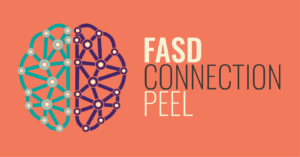Fetal Alcohol Spectrum Disorder (FASD) is a diagnostic term describing a spectrum of effects to an individual who was prenatally exposed to alcohol. As a result, the alcohol altered brain development and these individuals grow up with physical, mental, social and emotional disabilities that will last their lifetime. It is a brain disorder where there is no cure, only prevention.
It is important to remember that many individuals with FASD do NOT have the physical characteristics. As a result, FASD is often referred to as a hidden brain-based disability that is lifelong.
Under the 2015 Diagnostic Guidelines, the diagnostic terms include:
FASD WITH SENTINEL FACIAL FEATURES
- Small opening between the eye lids (palpebral fissure)
- Smooth or flattened area between nose and upper lip (philtrum)
- Thin upper lip
- Impaired brain function – 3 or more domains affected; in the case of infants and young children having an abnormally small head
- Confirmed or unconfirmed maternal alcohol exposure
FASD WITHOUT SENTINEL FACIAL FEATURES
- Impaired brain function – 3 or more domains affected
- Confirmed maternal alcohol exposure
Primary Characteristics
Individuals with FASD are born with effects to multiple brain functions. These effects are referred to as primary characteristics and commonly include:
MOTOR SKILLS
- poor eye-hand coordination executing small or large body movements
- diminished muscle tone poor reflexes
- difficulty balancing
- lack of co-ordination
NEUROANATOMY/NEUROPHYSIOLOGY (BRAIN STRUCTURE)
- could have a smaller brain and head circumference/li>
COGNITION (THINKING AND REASONING)
- difficulty reasoning, planning, solving problems and comprehending complex ideas
- difficulty with concepts, abstract ideas, consequences and managing time
- a wide range of IQ scores are found
LANGUAGE
- may speak well, but not fully grasp the meaning
- delay in language development
- difficulty understanding lengthy conversation and instructions
- can repeat instructions or rules accurately, but may not follow through
ACADEMIC ACHIEVEMENT
- difficulty in school: reading, math, comprehension, organization and abstract concepts
- learn best with visual and hands-on approach
MEMORY
- difficulty with long-term, short-term and working memory
- may appear to lie, but is filling in the blanks when unable to remember
- trouble with memorizing and may seem forgetful
- difficulty with accessing, selecting and organizing information when needed
ATTENTION
- can be easily distracted, over-stimulated, inattentive, hyperactive, and can’t sit still
EXECUTIVE FUNCTIONING INCLUDING IMPULSE CONTROL AND HYPERACTIVITY
- may have trouble with planning, sequencing, problem solving and organizing
- may be impulsive, have difficulty understanding cause and effect and controlling emotions
- challenges with transitions and change
- often repeats mistakes
- may under or over respond to stimulation
- inability to accurately sense what is going on in the environment
- struggle with sensory integration and sensitivity to light, noise, touch, smell and/or taste
- difficulty with self-regulation
AFFECT REGULATION
- predisposition to certain mental health concerns (eg. anxiety, depression and mood dysregulation disorders)
ADAPTIVE BEHAVIOUR, SOCIAL SKILLS OR SOCIAL COMMUNICATION
- may not understand personal boundaries and have difficulty reading social cues
- may be socially vulnerable and easily taken advantage of
- difficulty seeing things from another’s perspective
- socially and emotionally immature and may behave younger than actual age
Secondary Characteristics
Over time an individual may develop secondary defensive behaviours as a result of living in an environment not suited for their needs or having unreasonable expectations placed on them resulting in constant frustration and failure. With early identification and intervention, these secondary characteristics are believed to be preventable:
- Poor self-esteem
- Aggression
- Frustration
- Isolation, no friends
- Mental health disorders
- Disrupted school experience
- Family problems
- Employment issues
- Sexual problems
- Alcohol and drug addictions
- Trouble with the law
- Homelessness


